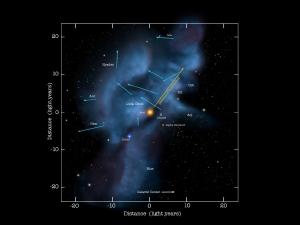Post
Dust in the Wind
16 September 2013
 NASA/Goddard/Adler/U. Chicago/Wesleyan
NASA/Goddard/Adler/U. Chicago/WesleyanWith all the news about Voyager 1 leaving the heliosphere and entering interstellar space you might think that the probe is the first spacecraft to detect interstellar particles. That isn’t entirely true, and the latest observations of interstellar particles has found some very interesting results.
The heliosphere is generated by the Sun’s solar wind, a stream of charged (ionized) particles that flows outward from the Sun. The solar wind interacts with the magnetic field of the sun, and together they create a kind of diffuse bubble of charged particles around the sun known as the heliosphere. While this heliosphere prevents any interstellar charged particles from reaching us, it is less effective at preventing uncharged interstellar particles from reaching us.
Most of the interstellar wind is ionized like the solar wind, but there are some neutral particles (mostly hydrogen) that moves with the interstellar wind. Since neutral particles don’t interact strongly with the Sun’s magnetic field, some of them can slip into the heliosphere, where we can detect them. This neutral hydrogen comes from the local cloud, seen below, a very tenuous cloud of hydrogen that surrounds our stellar region.
The motion of this hydrogen relative to the Sun depends on the Sun’s motion through the cloud and the motion of the cloud itself. The Sun’s motion through the galaxy is quite steady, and it was thought that the cloud’s motion was also steady, but long term observations of the hydrogen flow through our solar system has found this is not the case.
In a recent paper in Science researchers compared hydrogen flow measurements from the IBEX satellite (taken during 2009-2010) with observations from Ulysses (1992-2002) and other observations (1972-1978).1 What they found was that over the course of 30 years the direction has changed by about 6 degrees.
This may seem like a slow and gradual change, but on a cosmic scale it is huge. The local cloud is about 30 light years across, and the Sun moves through it at a speed of (only) about 50,000 mph (22 km/sec). While variations in the hydrogen flow are expected as it interacts with variations in the solar wind, those variations average out. Observing such a rapid change in flow (on a cosmic scale) means either there is turbulent flow within the cloud itself, or the interstellar wind is more dynamic than originally thought.
We’ve long known that the solar wind is quite dynamic due to the Sun’s activity. Now we’re finding the interstellar wind may be active as well.
Frisch, P. C., et al. “Decades-long changes of the interstellar wind through our solar system.” Science 341.6150 (2013): 1080-1082. ↩︎